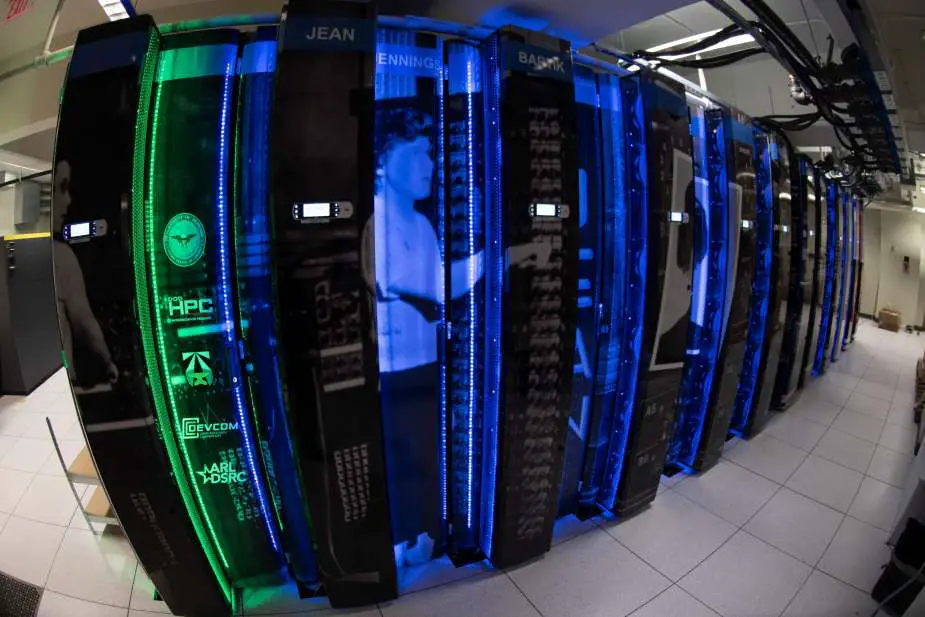Breaking news
US Army DEVCOM Army Research Laboratory Office of Strategic Communications receives new supercomputers.
U.S. Army researchers officially welcomed five new supercomputers with a ribbon cutting and naming ceremony on Sept. 28, 2023, at the Mallette Training Center. The U.S. Army Combat Capabilities Development Command, known as DEVCOM, Army Research Laboratory held a user group meeting with about 250 attendees. During that event, the laboratory held its public dedication of the latest ARL DOD Supercomputing Resource Center supercomputing systems.
Follow Army Recognition on Google News at this link

Jean is one of the unclassified supercomputers named by one of the original ENIAC programmers (Picture source: U.S. Army/Greg Newswanger)
The five new supercomputers, with a sixth one coming online next year, are named after the original six programmers of the world's first general purpose scientific computer, the ENIAC, which stands for Electronic Numerical Integrator and Computer. It began operation on Aberdeen Proving Ground in 1947. The original six programmers were: Jean Jennings, Marlyn Wescoff, Ruth Lichterman, Betty Snyder, Frances Bilas and Kay McNulty.
ARL officials honored the families of the six women, recognizing the groundbreaking contributions they made to the development of ENIAC and the creation of the field of computer programming. “They were mathematicians before they came to program computers,” said Cindy Bedell, director of the DEVCOM ARL Army Research Directorate. Bedell said when presented with the new ENIAC computer, the women met the challenge by learning how to program it to accomplish its mission.
Early computer engineers designed the ENIAC primarily to calculate artillery firing tables for the U.S. Army’s Ballistic Research Laboratory, which later became a part of the Army Research Laboratory. ENIAC was completed in 1945 and first put to work for practical purposes on Dec. 10, 1945.

File photo ENIAC computer at Aberdeen Proving Ground, Maryland (Picture source: U.S. Army)
The Cray was produced by Cray Research. Cray supercomputers were pioneering high-performance computing systems known for their innovative designs, record-breaking speed capabilities and applications in science and research. The brand became synonymous with cutting-edge supercomputing.
During the event, Prof. Kathy Kleiman, author of the book "Proving Ground" and creator of the documentary "The Computers: The Remarkable Story of the ENIAC Programmers," showed her documentary and gave a keynote address. “The story we are celebrating was lost for over 50 years,” Kleiman said.
In Kleiman’s documentary, she told the story of how the six women transitioned from doing calculations manually to programming the ENIAC to perform calculations in a fraction of the time. Due to a cultural focus on traditional gender roles in the 1950s, the accomplishments of the ENIAC Six were overlooked and nearly forgotten for decades, she explained. With this upgrade, the laboratory’s new supercomputer capacity exceeds the total capacity of all computers hosted at ARL since the inception of the HPCMP more than 30 years ago.
The High-Performance Computing Modernization Program was initiated in 1992 in response to congressional direction to modernize the Department of Defense laboratories’ high-performance computing capabilities.
The HPCMP funds and oversees the operation of five supercomputing centers, called DOD Supercomputing Resource Centers, or DSRCs. The centers are operated by the Engineer Research and Development Center in Vicksburg, Mississippi, the Army Research Laboratory in Aberdeen, Maryland, the Naval Meteorology and Oceanography Command in Stennis Space Center, Mississippi, the Air Force Research Laboratory in Dayton, Ohio, and Maui High-Performance Computing Center in Maui, Hawaii.
Defense News October 2023


























